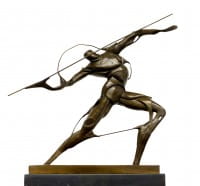Umberto Boccioni
Umberto Boccioni (1882–1916) was an influential Italian painter and sculptor who played a key role in the development of the Futurist movement in art.
Early life and education
Umberto Boccioni was born on October 19, 1882, in Reggio Calabria, a region in southern Italy. His family moved around Italy frequently due to his father's work, which exposed Boccioni to various regional art forms. He received his initial artistic training from a local painter in Forlì before studying at the Accademia di Belle Arti in Rome.
Career and Artistic Works
Boccioni's early work, much like that of his contemporaries, was influenced by the Divisionist style, a variant of Pointillism, which used dots of color to achieve luminous effects.
However, his style changed dramatically after he met Filippo Tommaso Marinetti in 1909. Marinetti was the founder of Futurism, an artistic and social movement that emphasized and glorified themes associated with the technology, speed, and industrial development of the modern age. Inspired by these ideas, Boccioni became a leading figure in the Futurist movement. He was a key author of the "Futurist Painting Technical Manifesto" and the "Manifesto of Futurist Sculptors" published in 1910 and 1912 respectively.
Boccioni's most famous works exemplify the Futurist fascination with motion and dynamism. Some of his most notable works include:
- The City Rises (1910): Considered the first Futurist painting, this artwork depicts the construction of Milan's new electrical power plant.
- Unique Forms of Continuity in Space (1913): This bronze sculpture is regarded as a masterpiece of Futurism. It represents a striding figure, enveloped by the dynamic forces of wind and speed.
- Dynamism of a Soccer Player (1913): This painting showcases Boccioni's attempts to express movement and the interpenetration of objects through multiple perspectives and simultaneous viewpoints.
Later Life and Legacy
Umberto Boccioni's life was cut short when he was fatally injured in a horse-riding accident on August 16, 1916, during World War I military training. Despite his early death at the age of 33, he left an indelible mark on the art world, particularly in terms of the Futurist movement. His works are seen as emblematic of the movement's innovative dynamism and continue to be studied and admired today. His works can be found in various prestigious museums around the world, including the Museum of Modern Art (MoMA) in New York and the Tate Modern in London.







